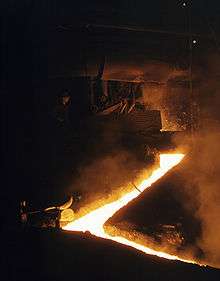Slag


Slag is the glass-like by-product left over after a desired metal has been separated (i.e., smelted) from its raw ore. Slag is usually a mixture of metal oxides and silicon dioxide. However, slags can contain metal sulfides and elemental metals. While slags are generally used to remove waste in metal smelting, they can also serve other purposes, such as assisting in the temperature control of the smelting, and minimizing any re-oxidation of the final liquid metal product before the molten metal is removed from the furnace and used to make solid metal.
Ore smelting
In nature, iron, copper, lead, nickel and other metals are found in impure states called ores, often oxidized and mixed in with silicates of other metals. During smelting, when the ore is exposed to high temperatures, these impurities are separated from the molten metal and can be removed. Slag is the collection of compounds that are removed. In many smelting processes, oxides are introduced to control the slag chemistry, assisting in the removal of impurities and protecting the furnace refractory lining from excessive wear. In this case, the slag is termed synthetic. A good example is steelmaking slag: quicklime and magnesite are introduced for refractory protection, neutralising the alumina and silica separated from the metal, and assist in the removal of sulfur and phosphorus from the steel.

Ferrous and non-ferrous smelting processes produce different slags. The smelting of copper and lead in non-ferrous smelting, for instance, is designed to remove the iron and silica that often occurs with those ores, and separates them as iron-silicate-based slags. Slag from steel mills in ferrous smelting, on the other hand, is designed to minimize iron loss and so mainly contains oxides of calcium, silicon, magnesium, and aluminium. Any sandy component or quartz component of the original ore automatically carries through the smelting process as silicon dioxide.
As the slag is channeled out of the furnace, water is poured over it. This rapid cooling, often from a temperature of around 2,600 °F (1,430 °C), is the start of the granulating process. This process causes several chemical reactions to take place within the slag, and gives the material its cementitious properties.
The water carries the slag in its slurry format to a large agitation tank, from where it is pumped along a piping system into a number of gravel based filter beds. The filter beds then retain the slag granules, while the water drains away and is returned to the system.
When the filtering process is complete, the remaining slag granules, which now give the appearance of coarse beach sand, can be scooped out of the filter bed and transferred to the grinding facility where they are ground into particles that are finer than Portland cement.
Ancient uses

During the Bronze Age of the Mediterranean there were a vast number of differential metallurgical processes in use. A slag by-product of such workings was a colorful, glassy, vitreous material found on the surfaces of slag from ancient copper foundries. It was primarily blue or green and was formerly chipped away and melted down to make glassware products and jewelry. It was also ground into powder to add to glazes for use in ceramics. Some of the earliest such uses for the by-products of slag have been found in ancient Egypt.[1]
Historically, the re-smelting of iron ore slag was common practice, as improved smelting techniques permitted greater iron yields—in some cases exceeding that which was originally achieved. During the early 20th century, iron ore slag was also ground to a powder and used to make agate glass, also known as slag glass.[2]
Modern uses
Ground granulated slag is often used in concrete in combination with Portland cement as part of a blended cement. Ground granulated slag reacts with water to produce cementitious properties. Concrete containing ground granulated slag develops strength over a longer period, leading to reduced permeability and better durability. Since the unit volume of Portland cement is reduced, this concrete is less vulnerable to alkali-silica and sulfate attack.
This previously unwanted recycled product is used in the manufacture of high-performance concretes, especially those used in the construction of bridges and coastal features, where its low permeability and greater resistance to chlorides and sulfates can help to reduce corrosive action and deterioration of the structure.[3] The slag can also be used to create fibers used as an insulation material called slag wool.
Basic slag
Basic slag is a co-product of steelmaking, and is typically produced either through the blast furnace -- oxygen converter route or the electric arc furnace—ladle furnace route.[4] To flux the silica produced during steelmaking, limestone and/or dolomite are added, as well as other types of slag conditioners such as calcium aluminate or fluorspar. The major components of these slags therefore include the oxides of calcium, magnesium, silicon, iron, and aluminum, with lesser amounts of manganese, phosphorus, and others depending on the specifics of the raw materials used.
Because of the slowly released phosphate content in phosphorus-containing slag, and because of its liming effect, it is valued as fertilizer in gardens and farms in steel making areas. However, the most important application is construction.[5]
See also
| Wikimedia Commons has media related to Slag. |
References
- ↑ "The chemical composition of glass in Ancient Egypt by Mikey Brass (1999)". Retrieved 2009-06-18.
- ↑ "Glass (G) – Encyclopedia of Antiques". Encyclopedia of Antiques. Retrieved 5 April 2014.
- ↑ "High Performance Cement for High Strength and Extreme Durability by Konstantin Sobolev". Archived from the original on 2009-08-03. Retrieved 2009-06-18.
- ↑ Fruehan, Richard (1998). The Making, Shaping, and Treating of Steel, Steelmaking and Refining Volume, 11th Edition. Pittsburgh, PA, USA: The AISE Steel Foundation. p. 10. ISBN 0-930767-02-0.
- ↑ http://www.fehs.de/eisenhuettenschlacken/statistik/
Further reading
- Dimitrova, S.V. (1996). "Metal sorption on blast-furnace slag". Water Research. 30 (1): 228–232. doi:10.1016/0043-1354(95)00104-S.
- Roy, D.M. (1982). "Hydration, structure, and properties of blast furnace slag cements, mortars, and concrete". ACI Journal Proceedings. 79 (6).
- Fredericci, C.; Zanotto, E.D.; Ziemath, E.C. (2000). "Crystallization mechanism and properties of a blast furnace slag glass". Journal of Non-Crystalline Solids. 273 (1–3): 64–75. doi:10.1016/S0022-3093(00)00145-9.